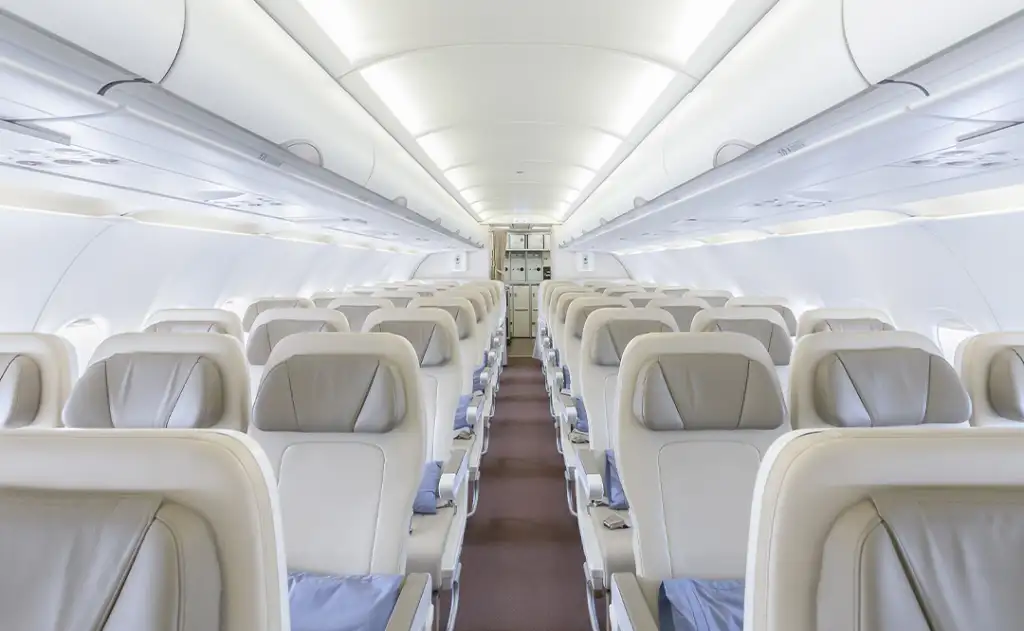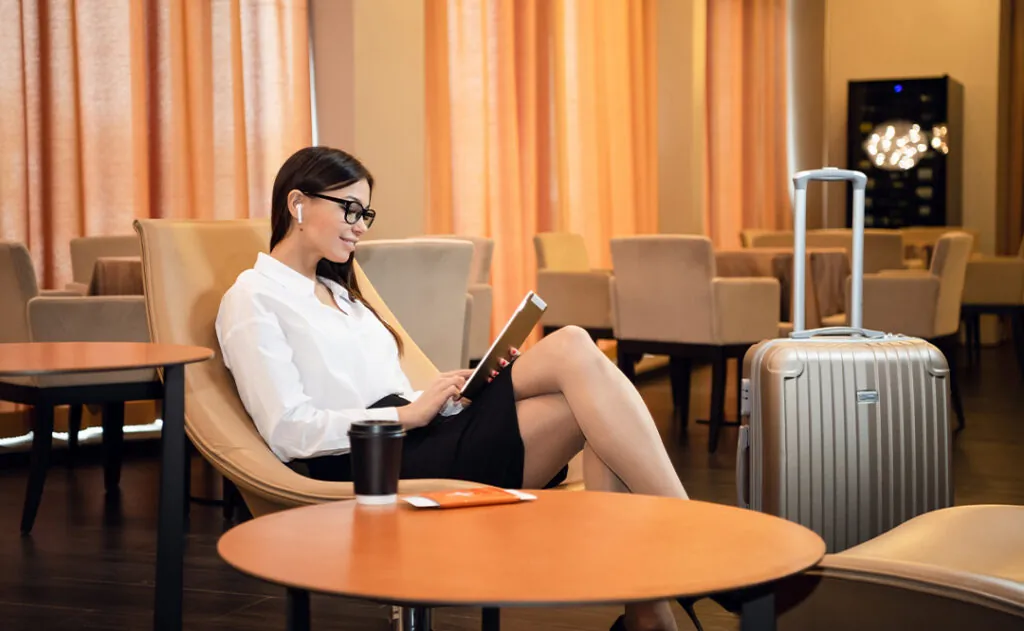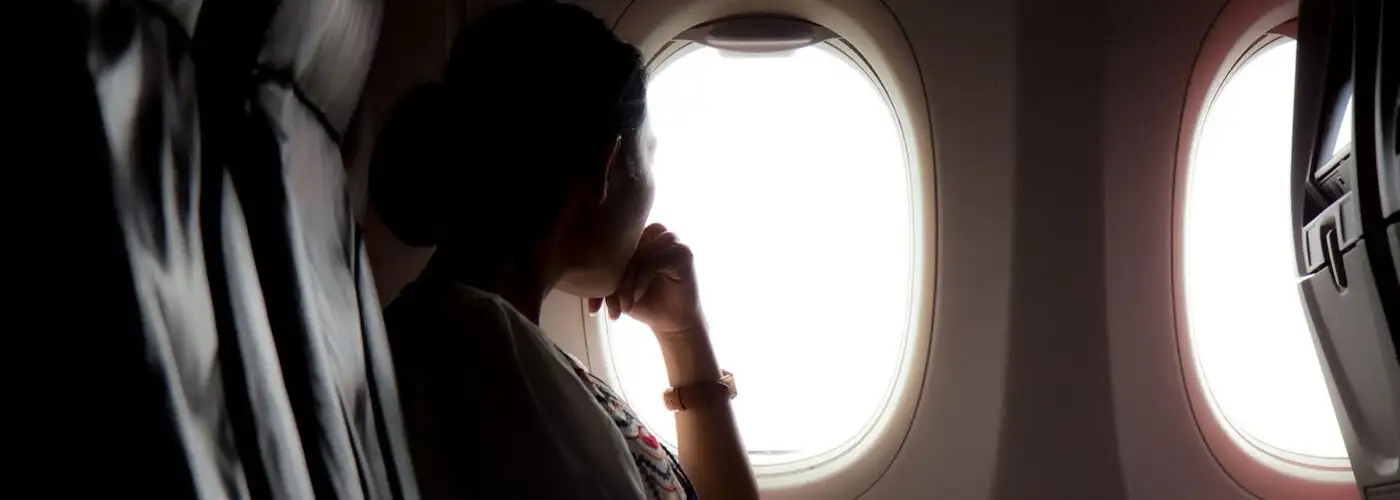Many people love traveling and seeing new places, but there’s one part of travel that isn’t so fun: flying. For some, flying is simply a hassle, thanks to high fares, flight delays, and lost luggage. But for other travelers, flying is more than inconvenient; it’s terrifying.
Fear of flying can be caused by a number of factors, including claustrophobia or a fear of heights. Many nervous flyers feel irrational anxiety that their plane will malfunction and crash, no matter how many times they hear the statistics about how safe flying is compared to driving. Other travelers worry about terrorist hijackings or panic at the idea that they’re not in control of the aircraft that’s carrying them.
No matter why you’re scared of flying, there are certain steps you can take to help alleviate your fears. To fly or not to fly is a personal decision and one that no one else can make for you. But for those who are determined not to let this change your way of life, below are a few tips for overcoming your fear of flying.
Before Your Trip
Know What to Expect
For many fearful flyers, learning the basics of how airplanes work can go a long way toward alleviating their anxiety. For instance, understanding how a plane can continue to fly even if an engine fails can help you feel less concerned about your aircraft malfunctioning. GuidetoPsychology.com offers an easy-to-understand explanation of how planes stay in the air, what causes turbulence, and what’s behind those scary sounds during takeoff and landing.
Dr. Margaret Wehrenberg, PsyD, a licensed clinical psychologist and author of The Anxious Brain and The 10 Best-Ever Anxiety Management Techniques, recommends asking yourself: “What is the catastrophe? What do I actually think will happen? What am I making a big deal out of? … Answer these questions before you get on the plane.”
Familiarize Yourself with Your Plane
Getting to know what your plane looks like can make it seem a little less scary. I once heard of a fearful flyer who actually put a picture of the plane’s cabin on her computer’s desktop; by the time her flight rolled around, the image was familiar, not scary.
Once your flight is booked (and even before), you can see what kind of plane you will be flying on. While a simple seat map probably won’t help alleviate much anxiety, you can do a quick search on Google Images for the interior of that airplane and easily find a photo so you are prepared for what the interior looks like – if there are three seats, a middle aisle, built-in screens- you’ll know what to expect when you step off of the passenger boarding bridge onto the plane.
Choose The Right Seat

Most airlines and booking engines allow you to request a seat assignment when you book your flight. Request an aisle seat, particularly if you’re prone to claustrophobia; you’ll feel less hemmed in by other people, and you’ll be able to get up and move around the cabin more easily. This also makes it easier to avoid looking out the window if those sky-high views make you nervous. (For more information on nabbing the seat you want, see 10 Ways to Get the Best Airplane Seat.)
Request a window seat if you think you’ll be more comfortable seeing what is going on outside of the plane. Seeing the clouds, blue sky, and dotted lights of the towns and cities below may give you a sense of control. When there is turbulence, knowing you are going through a cloud will help ease your worries.
If you are booking with an airline that only lets you pick your seat for a fee- pay it. If you have booked with an airline like Southwest that has no assigned seating but assigns a boarding order, check in as soon as possible so you are in the earliest boarding group.
Monitor Your Media Intake
This may seem like a no-brainer, but it’s worth mentioning: Avoid airplane disaster movies, news coverage of plane crashes, or other scary media images. Remember that the vast majority of flights arrive safely, but only the problem flights make the news. Don’t let that skew your impressions of flying.
Instead of watching anything that could increase your anxiety, try meditation music or a guided meditation specifically for fear of flying. Anything that won’t spark extra anxiety will help lead up to your flight.
Think Positive
It’s easy to let the flight anxiety build in the days leading up to your trip. When this happens, counter your fear of flying with the exciting prospect of getting to be on a plane, hopefully going somewhere fun. Try to focus on the positive—like all the things you’ll do once you reach your destination.
Remember- you are not alone. Millions of people fly every day worldwide, and most get to their destination without anything happening. Chances are, you’ll be with the millions of people who travel daily without a glitch.
At the Airport
Don’t Rush
Allow yourself plenty of time to get to the airport before your flight is scheduled to depart. Racing to the gate and worrying about missing your plane will only add to your anxiety. For more advice, see How Early Should I Get to the Airport?
Once you are through security, familiarize yourself with where your gate is so you can gauge how far it is from restaurants, cafes, stores, and restrooms- that way, you’ll know how long it will take you to get there, and you won’t be rushing.
When you’ve found your gate, find a restaurant or cafe to sit and relax. Bring a good book or queue up a (relaxing) podcast to bide your time. Or simply people watch- often, seeing everyone else at the airport doing exactly what you are doing without a care in the world may help you feel better about your flight.
Get to your gate in plenty of time for boarding, with a stop at the restroom. This way, you can hear all announcements and won’t have the added stress of running to your gate for boarding.
Wait for Your Flight in an Airport Lounge

Most airlines have private airport lounges that are quiet, luxurious oases away from the hustle and bustle of the rest of the airport. While they’re usually reserved for club members or elite flyers, you can often purchase a day pass for about $50—which may be a small price to pay for a soothing place to relax and prepare for your flight.
Programs like Priority Pass have a yearly fee and get you access to airport lounges in airports all over the world. Purchasing something like this may be worthwhile if you plan on flying frequently. Some credit cards like Capital One Venture X, American Express Platinum, and more include airport lounge access, so be sure to check the rewards that come with your credit card.
On the Plane
Meet the Crew
If there’s time before your flight, ask to meet the pilot of your plane. Alternatively, spend a minute or two chatting with a flight attendant. Often, meeting the folks who hold your safety in their hands can make the plane seem like a friendlier environment and reassure you that the crew is knowledgeable and competent.
Once you are on the plane, telling the flight attendants you are nervous is okay. They are trained to be pleasant and will likely assure you you’re in good hands.
Tune In
Ensure your phone or tablet is stocked with soothing music to help get you into a peaceful frame of mind. Download stress-busting meditation or instructional breathing sessions from an app such as Headspace (iOS | Android) or Simple Habit (iOS | Android) to listen to them when your phone is in airplane mode.
You can also load up your phone with classical music, which has been proven to be good for your mental health. If you have a favorite album or musician, listening to familiar songs can also be beneficial.
Remind Yourself Who’s in Charge
Many anxious flyers are bothered by their perceived lack of control since they have no influence over the safety or performance of the aircraft. Try to regain a little control by reminding yourself that you made the decision to fly and that you can decide how you respond to the experience.
It can be helpful to keep track of your flight while flying; knowing where you are, how much time you have left, and what the path is can help you feel like you have some control over the flight.
Breathe
As anxiety increases, your breathing may get shallow—but deep, conscious breathing is an instant stress reliever. Breathe slowly and deeply for a count of five or 10, in through your nose and out through your mouth.
Although this bit of advice may seem obvious, breathing is arguably the best way to vanquish anxiety. Dr. Wehrenberg explains that controlled breathing works because “breathing is the one thing that will stop a panic attack.”
Turning on the air vents above your head, leaning back, and closing your eyes may help you feel less claustrophobic. Sniffing a lavender sachet or sucking on a peppermint are other calming, meditative tricks.
A Sensate device can help you calm down using vibrations and sound to lower your stress. Using an infrasonic resonance, it relaxes your vagus nerve, helping you to calm down for your flight.
Read or Watch Something Fun
Pack a magazine, a good book, or a puzzle to take your mind off what’s happening. Order up a comedy on your plane’s in-flight entertainment system, or preload a few of your favorite flicks onto your laptop. Be sure to stock up on activities that will last you the duration of your flight and that you can continue to enjoy when it’s time to turn electronic devices off.
If your airplane has in-flight entertainment, you can usually see what movies and TV shows will be available on your flight beforehand. Look ahead of time and find something that will help the time go by; something funny and not tense will be your best bet for keeping you calm and distracted.
Have a Drink or CBD

Many nervous flyers turn to alcohol to calm their nerves. While this may be fine in moderation, keep in mind that alcohol should not be combined with anti-anxiety medications. Also, alcohol can contribute to dehydration, particularly in the arid environment of an airplane. If you treat yourself to a cocktail, follow it up with plenty of water.
CBD is allowed on airplanes, and a great way to calm nerves is by dropping a few drops of CBD oil on your tongue. Something like CBDFX Calming Tincture Oil will help you relax and comes in a 1oz bottle, so won’t take up much room in your bag.
Avoid Caffeine
This and other stimulants can make you even more jittery. Try to avoid caffeine in the hours leading up to your flight, as well as when you are on the plane. Adding extra stimulants will not help your anxiety.
If you need a hot drink, go with an herbal tea. The Republic of Tea has a Relax tea containing herbs proven to calm you. Not a tea drinker? Many alternatives will give you the energy you need without the jitters. We love MUD/WTR, and their Morning Ritual Starter Kit will have everything you need to make yourself a coffee-like beverage without the added agitation.
Go with the Flow
Recognize that panic is temporary and that it will pass. If you are afraid of losing control and succumbing to fear during the flight, remind yourself that even a full-on panic attack is only a temporary affliction; you’ll get through it.
Take the flight step by step: getting to the airport, getting through security, boarding, getting in your seat, taking off, cruising, the descent, and landing. By compartmentalizing each stage of the flying process, it can help the time pass more quickly.
If anything happens during the flight that makes you nervous- look around and see what the flight attendants and other passengers are doing. When the flight attendants are calmly walking the aisles, handing out drinks, you’ll know there is nothing to worry about. When the woman who clearly travels for business is sitting in her seat, continuing to work on her laptop, you can sit back and be assured what is happening is a normal part of the flight.
More Fear of Flying Help
Pop a Pill
If your fear is particularly debilitating and you’ve tried other relaxation techniques without success, ask your doctor if it may be worth taking an anti-anxiety medication or a sleeping pill before you fly.
There are over-the-counter options available as well. Magnesium, T-Theanine and Ashwagandha are all supplements that people take for anxiety. There are plenty of over-the-counter sleeping pills you can try, too. Remember, as with any medication, be sure to check with your doctor before taking them.
Contact a Professional
How do you know when it’s time to make an appointment with a medical professional? Says Dr. Wehrenberg, “If you’re losing sleep, feeling sick with anxiety, or avoiding travel at the expense of your own or other people’s convenience,” a licensed therapist or counselor can help you figure out the root causes of your fear and how to overcome them.
If you have time before your flight, consider Cognitive Behavioral Therapy (CBT). Through behavioral changes, meditation, and several other cognitive techniques, a CBT therapist can help prepare you for flying.
Go Online
There are loads of special online programs and websites that will help you get over your fear. From tips, self-help programs, as well as seminars, and even a workbook, there is something for everyone, no matter what your learning preference is. Here are a few to try:
- SOAR offers free tips, newsletters, chats, videos, and more comprehensive counseling and programs for a fee.
- Anxieties.com offers a free online self-help program for those who want to overcome their fear of flying.
- GuidetoPsychology.com is a comprehensive site with information about how airplanes work and tips for overcoming your fear of flying.
- Fearless Flyer has a video explaining the PATH Method (Psychological and Technical Hack), giving you a less than 30-minute option to help you curb your fear.
- Fearless Flight is run by a former pilot, Captain Ron. With his expertise, he offers fear of flying classes, as well as a live, monthly group coaching webinar.
Fear of Flying Workbook is a workbook to help you get over your fear. Through questionnaires, checklists, an in-flight panic journal, symptom and responses, as well as breathing and meditation exercises, the book has everything you need to help you with your flight when you’re afraid.
You Might Also Like:
• How to Properly Disinfect Your Airplane Seat• 11 Amazing Solo Vacations to Take in 2024
• 18 Things You Should Always Wear on a Plane
• 10 Travel Secrets I Learned Working in a Hotel
• 11 Important Rideshare Safety Tips for Travelers
We hand-pick everything we recommend and select items through testing and reviews. Some products are sent to us free of charge with no incentive to offer a favorable review. We offer our unbiased opinions and do not accept compensation to review products. All items are in stock and prices are accurate at the time of publication. If you buy something through our links, we may earn a commission.
Related
Top Fares From
Today's Top Travel Deals
Brought to you by ShermansTravel
Australia: Upscale, 8-Night Cairns, the Gold...
Down Under Answers
 vacation
$3899+
vacation
$3899+
Greenland: Luxe, All-Incl. 11-Nt Exploration Small-Ship...
Swan Hellenic
 cruise
$3289+
cruise
$3289+
Ohio: Daily Car Rentals from Cincinnati
85OFF.com
 Car Rental
$19+
Car Rental
$19+




